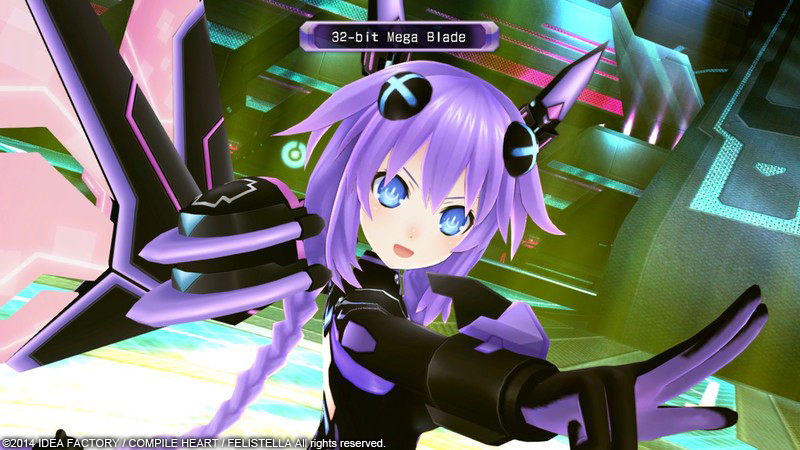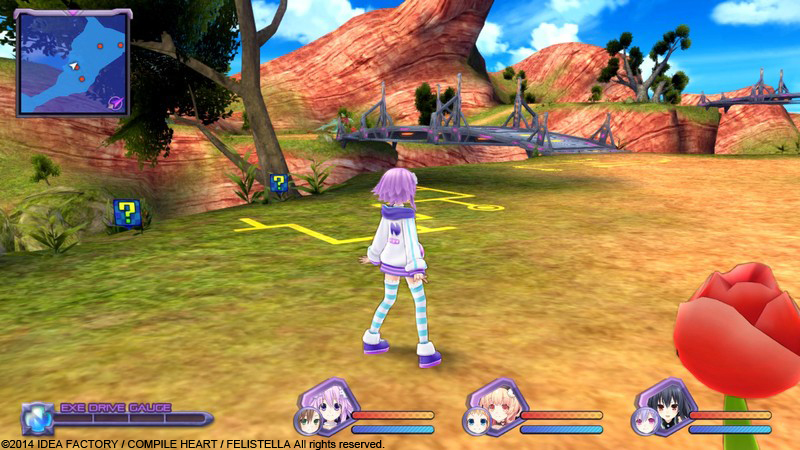The History of Neptunia: The Re;Birth series
Following the release of Hyperdimension Neptunia Producing Perfection — and after the initial trilogy of games had proven surprisingly popular, picking up a growing cult following with each new installment — developer Compile Heart saw fit to go back to the original games and revamp them for the PlayStation Vita.
Evidently keenly aware that the first game in particular had a lot of mechanical elements that people weren’t all that fond of, the team made the decision to bring all the games in line with one another, rebuilding the first two to feel a bit more like Hyperdimension Neptunia Victory.

In the case of mk2, this wasn’t a huge undertaking, because mk2’s mechanics were already quite similar to Victory’s; the Re;Birth-ification was mostly about balance and adding a few new features. Likewise, since Victory was being used as the basis for all three Re;Birth games, the third installment in the trilogy of remakes was mostly, again, about tweaking things and adding a few new features.
When it came to the first game, though, there was a clear opportunity for a complete reinvention. And this makes Hyperdimension Neptunia Re;Birth1 probably the most interesting of the three.
The overall story of Hyperdimension Neptunia Re;Birth1 is broadly similar to the original game, but unlike both Re;Birth2 and 3, which are mostly based on their previous incarnations’ scripts, it’s been completely rewritten. And this being a Neptunia game, there’s a certain amount of fourth-wall breaking along the way to make it clear that at least some of the characters — most notably Neptune — are well aware that this is a remake.

As a result of the rewrite and completely revamped mechanics, Hyperdimension Neptunia Re;Birth1 feels like a completely different game to the first Hyperdimension Neptunia — because it is. Meanwhile, Re;Birth2 and 3, while still good, feel much more similar to their source material, as you might expect; remasters as opposed to remakes, if you will.
One of the most significant additions to all three Re;Birth games is a mechanic known as the Remake System. This is essentially a crafting system, only instead of creating items you’re tweaking the game itself in a variety of ways. They’re often also tied to in-game achievements of some description such as seeing a particular event or locating a hidden treasure, meaning you can’t just unlock them all from the outset.
Remake plans, as the recipes are called, fall into a number of different categories. The most interesting are probably the System plans, which actually change the way the game works in a few ways.

For example, you can adjust the difficulty, break the damage limit, unlock the colosseum battle mode, tweak how symbol attacks work and even unlock additional characters — according to Hyperdimension Neptunia Re;Birth1, the sisters of all the goddesses (who weren’t originally introduced until mk2) were created through the Remake system, at least in the dimension the original Hyperdimension Neptunia unfolded in.
Elsewhere, Remake plans can be used to change the enemies and item drops that can be found in various dungeons, allowing you to track down rare items which, in turn, are often used to make further plans. You can also develop new consumable items and weapons, which can subsequently be purchased in stores, and even new costumes and accessories for all the main characters.
The Remake system adds a great deal of depth to all of the games, since after a while chasing down the ingredients for the various plans and unlocking them becomes surprisingly compelling.

Hyperdimension Neptunia Re;Birth2 adds another new system, which is subsequently reprised in Re;Birth3: Stella’s Dungeon, intended to be a handheld-friendly bonus game designed with some of the principles of mobile gaming. It’s very simple at its core, consisting of you sending the character Stella (an embodiment of Felistella, a developer who worked on the Re;Birth games with Compile Heart) into one of the game’s dungeons and then, after a period of real time has elapsed, receiving a report back from her.
There is a touch more depth to it than that in that you can equip Stella with various items that improve her stats and make her more likely to make it through various challenges unscathed, but for the most part it’s an addition to the formula designed to be played “in the background”; Stella continues to make progress through her dungeons even when the Vita is in sleep mode, so it’s something that tends to be best triggered before you’re done with your gaming for the day.
Both the Remake system and Stella’s Dungeon are replacements for the Scout system which appeared in Hyperdimension Neptunia Victory. They have the same core functions — tweaking the game in various ways, and passively acquiring goodies — but a bit more substance to them. And in all three games, the Remake system is pretty much critical to progression after a certain point, both in terms of unlocking dungeons and powering up your characters.

Probably the most important thing to note about the three Hyperdimension Neptunia Re;Birth games is that they are, by far, the most accessible means of getting started with Neptunia these days. Although initially released on PlayStation Vita, they were subsequently ported to PC and can now be easily acquired through services such as Steam and GOG.com, where they frequently enjoy deep discounts. The Vita versions, meanwhile, can still be bought digitally while the PlayStation Store supports Vita, though the physical versions are rapidly increasing in price as time goes on.
And they’re all great games! While the fact they all now run on the same core mechanics makes them feel a little less markedly distinct from one another from a gameplay perspective, the entertaining stories of these first three installments are as enjoyable as they ever were — and if you were planning on playing Neptunia: Sisters vs Sisters any time soon, Re;Birth2 in particular is well worth playing beforehand.
So if you’re yet to jump into the Neptunia series in earnest and were wondering where the absolute best possible place to begin was, it’s these three games. Sure, the series is mostly designed in such a way that you can get on board with pretty much any installment — but if you want the full Nep experience, these are the best means of going back to where it all began.
Join The Discussion
Rice Digital Discord
Rice Digital Twitter
Rice Digital Facebook
Or write us a letter for the Rice Digital Friday Letters Page by clicking here!
Disclosure: Some links in this article may be affiliate links, which means we may earn a small commission if you make a purchase after clicking on them. This is at no additional cost to you and helps support Rice Digital!
- Letter from the Editor: passing the torch - June 30, 2023
- Super Woden GP 2 is looking promising - June 30, 2023
- Inti Creates is making a 32 bit-style Love Live action platformer - June 26, 2023







